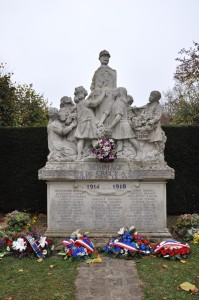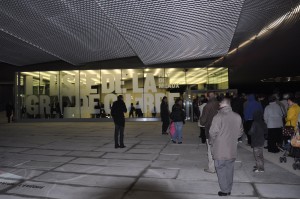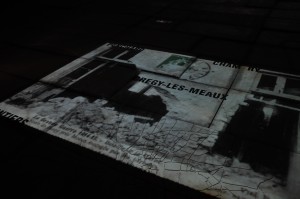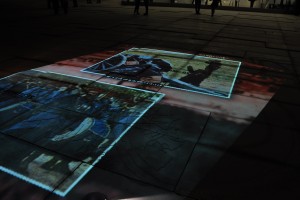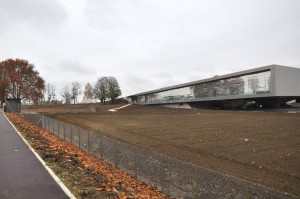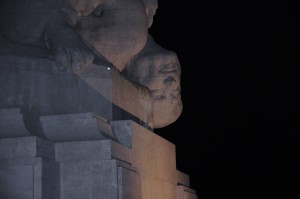The Museum of the Great War officially opened on 11 November 2011, the 93rd anniversary of the Armistice. The ceremony was intended to take place at 11:00, apparently, but was pushed down to 3:00; speeches aired at 4:00 suggesting that there were further delays. Doors opened to the public at 6:00.
My Dear One and I were part of that public.
We had an early supper (the remains of the roasted chicken bought at yesterday’s market in Crécy-la-Chapelle and the last of the sauerkraut), set aside the vanilla éclairs for later, and headed to Meaux. The trip was quick and easy; there was no traffic until we were about three kilometers from the building. Then there was a lot of traffic and a notable absence of traffic direction.
Parking was completely inadequate.
We were turned away from the lot, couldn’t see anything along the rue de Varreddes, circled the roundabout at the corner and came back for a second look. This time we could see cars entering the pavement leading to MacMonnies’ giant sculpture. We wedged ourselves into a space that surely was never intended for that use and walked around to the entrance.
The line of visitors stretched from the building across the plaza and down the walkway, a crush five or six people wide. Children were tearing around, neighbors were greeting each other. The wind was icy and the temperature was maybe forty degrees, feeling colder because of windchill.
Light and color—a montage of vintage film footage and animations—swam across a section of the plaza, flickering over a map of the region carved into the pavement. Museum staff came by handing out melting-plastic cups of hot tea and coffee. Every so often we shuffled forward. A baby who may have been ten or twelve months old screamed in his father’s arms. Other families had loaded wee ones into strollers. I was in total sympathy with the screamer. What on earth were these parents thinking of? It was dark, late and cold and I could not imagine what such an experience could be for these tots except punishment.
We shuffled forward a few more times. Finally we could see the doors and the press of bodies beyond. We could also see Jean-François Copé, Chairman of the Communauté d’Aglomération de Pays de Meaux. Copé presided over the ceremonies alongside President Nicolas Sarkozy and appears to covet Sarkozy’s job. Monsieur Copé, a balding man with Gallic good looks and obvious charm, came through the doors, pressing the flesh and smiling. My Dear One pushed me forward and I managed to shake his hand and wish him and the institution well on behalf of the American people. He shifted into flawless English, thanked us, and encouraged us to see the last gallery at the end of the installation which was devoted to the American presence in the war.
(The next morning when we shared this anecdote with Colette, doyenne of Milleroses, she was theatrical and very, very funny in her demonstration of distaste for the man. In the background the morning news repeatedly mentioned that Copé was scolding the Netherlands for their willingness to engage with the leftist Green Party on the matter nuclear energy.)
We shuffled forward and up some steps. It was by now about eight o’clock and we had been in line for almost two hours. Finally we arrived at the entrance to a “projection.” I asked a staff member how to skip the projection and get on with our tour. We could decline to watch the film, which would last about five minutes, she said, but we still had to get through that space to get to the displays beyond. So we waited a little while longer.
My recollection of the museum is of lights and books and uniforms and weapons and an astonishing range of artworks and artifacts. The collection is the life work of Jean-Pierre Verney, an acknowledged expert in World War One and a distinguished amateur in the admirable 18th– or 19th-century sense of the word. He was offered $2.7 million for it, but opted to accept something around $800,000, and have the guarantee of the museum.
The museum approaches the story of the Great War thematically, using chronology only as a general armature for these themes. Labels are trilingual: largest print is French but translations into English and German are also there. Displays are organized in such a way as to engage children, and in fact, it may be a model museum, educationally speaking, for families. It certainly should be interesting to people not well informed about the war. It does not, however, offer the harsh realities that one encounters, say, at the Memorial Museum in Fleury in the Verdun battlefields. Both have their place. I would not say that the one in Fleury-Verdun is better; it is, however, the one I feel I would like to go back to.
The fact is, however, that we zoomed through the space quickly, it was late and we were tired, and we were stressed from the long and mostly frigid wait.
There are a number of museological criticisms I would raise, though. The entrance is confusing and the Accueil/Reception does not appear to be located where it can be immediately seen. The passageways from gallery to gallery and space to space are narrow; they will be a problem for people in wheelchairs and for school groups. Similarly, there is inadequate space for skirting a visitor who is examining a display; one or the other of the visitors, or both, will be inconvenienced.
My other criticism is about the didactic shape of the museum. The appearance is that of an encyclopedic review of the war but this appearance is misleading. In the absence of an assertive timeline, the sense of the rise and fall of Allied fortunes gets lost. The identity of the institution is intertwined with that of the Pays de Meaux. The key battlegrounds of the Marne, the Meuse, the Somme and the Saint-Mihiel Salient get short shrift.
As an American, I feel that my nation’s contributions are blurred. There isn’t much attention paid to U.S. support of the Allies, economic involvement, or volunteer efforts, all of which preceded our entrance into the war in April 1917. The role the American Expeditionary Force played in the final resolution also seems unclear. Even the symbolic presence of the MacMonnies’ sculpture adjacent to the museum seems to get lost. The building itself turns a metaphorical back on the sculpture and there is no effort to conjoin these contrasting monuments to memory in any meaningful way.
On 11-11-11, when the nations of the West stop to remember what was lost and analyze what may have been gained by the carnage of the War to End All Wars, this new museum opened to great fanfare. While I assume that there was some sort of diplomatic presence by the United States, I could find no American names in the recitations of honored guests. As we walked back to our car after all the fanfare, only a single light illuminated the gift from America intended to commemorate French valor at the first battle of the Marne. The only detail visible was a single sorrowing face.

